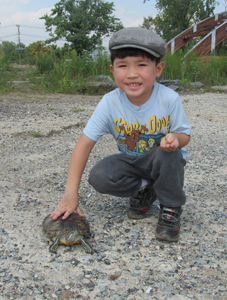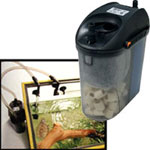
Do Not Buy Hatchlings!
Although newly-hatched Sliders are still offered for sale, usually at fairs, carnivals and street stalls, it is illegal to sell them (or any turtle less than 4 inches in length) in the USA, and has been since 1975. The law was enacted by the Food and Drug Administration in response to Salmonella outbreaks linked to hatchlings. For further information on the Salmonella- turtle connection, please see this article.
Because Sliders grow much faster than most owners expect, turtle rescue organizations are swamped with unwanted pets. Please consider adopting rather than purchasing a turtle; please post below if you need adoption assistance.
The Aquarium
Sliders grow rapidly, and may attain full size within 2-4 years. Females reach 8-12 inches in both length and width (think large dinner plate) while males generally top out at 6 inches. Being quite active, an adult female will require a 55-75 gallon aquarium at minimum; a male might get by in a 30 gallon, but more room (for either sex) is preferable.
Zoo Med’s Turtle Tub makes an excellent home for large and small Sliders.
Children’s wading pools or koi ponds are often easier to manage than aquariums, especially if you have more than one turtle. Plastic storage bins can easily be modified into low-cost turtle homes. Please post below for further information.
Basking Site
Red-Eared Sliders need a non-abrasive surface on which to rest and dry off. The basking site should be located beneath a heat and UVB bulb, so that your turtle can attain its ideal body temperature and manufacture Vitamin D3 within the skin (see Heat and UVB Bulbs, below).
I prefer basking sites that are suspended at the water’s surface, as these do not take up valuable swimming space. Zoo Med’s Turtle Dock features a sloping ramp and is available in several sizes.
Larger individuals may partially submerge platforms that attach to aquarium glass, and hence will not be able to completely dry-off while basking. The Penn Plax Turtle Pier has a gravel reservoir to offset the weight of larger turtles, and also provides a sub-surface hiding and resting spot.
Cork bark also works well, especially if wedged between the aquarium’s sides.
Filter
 You can do without a filter if your turtle lives in an easily-emptied plastic bin. However, filtration is essential if you maintain these messy feeders in an aquarium. A wide variety of submersible and canister filters, designed specifically for use with turtles, are now available. Please see this article to read about my favorite types. A siphon will simplify waste removal and partial water changes.
You can do without a filter if your turtle lives in an easily-emptied plastic bin. However, filtration is essential if you maintain these messy feeders in an aquarium. A wide variety of submersible and canister filters, designed specifically for use with turtles, are now available. Please see this article to read about my favorite types. A siphon will simplify waste removal and partial water changes.
Feeding Enclosure
Although not essential, a separate feeding enclosure, such as a plastic sweater box, will ease the filter’s job and limit the frequency of water changes. Please see this article for more on maintaining water quality.
Water Heater
Use a “turtle proof” submersible heater to maintain your Slider’s water at 76-82 F and a reptile thermometer to monitor water and air temperature.
Heat Bulb
An incandescent “spot type” bulb should be employed to heat the basking site to 85-90 F. The basking light will usually warm the rest of the enclosure sufficiently (78-82 F). If additional heat is needed, red/black night bulbs or ceramic heater-emitters may be added.
Ultra Violet-B (UVB) Bulb
Red Eared Sliders need daily exposure to UVB light. Your turtle should be able to bask within 6-12 inches of a high-output UVB florescent bulb, such as the Zoo Med 10.0 . Mercury vapor and halogen bulbs broadcast UVB over greater distances, and emit beneficial UVA radiation as well.
Natural sunlight is ideal, but be aware that UVB rays do not penetrate glass or plastic, and that fatal overheating can occur quickly.
Substrate
Sliders are best kept in bare-bottomed aquariums; gravel traps dirt, complicates cleaning, and may be swallowed.
Food
Young Red-Eared Sliders are largely carnivorous, but increasingly consume plants as they mature. By adulthood, vegetation forms the bulk of the diet.
Reptomin Food Sticks and trout chow provide excellent nutrition; either can serve as up to 50% of the diet.
Dandelion, kale, mustard and collard greens, romaine, endive and aquarium plants such as Elodea, Anachris, Watersprite and Duckweed should be offered.
Whole freshwater fishes such as minnows and shiners are the best source of calcium (and other valuable nutrients) for turtles. Offer fish at least once weekly, but use goldfishes sparingly (please see this article).
Other important food items that should be a regular part of the diet include earthworms, canned snails and fresh or freeze-dried shrimp and krill. Crickets, mealworms, waxworms and other insects may be offered on occasion.
Although best known to most folks as pets, Sliders also have a fascinating natural history. Please see the articles below to read about their lives in the wild.
Further Reading
Lesser-Known Relatives of the Red Eared Slider
 That Reptile Blog – Reptile, Amphibian and Exotic Pet Care and Information
That Reptile Blog – Reptile, Amphibian and Exotic Pet Care and Information



One comment
Pingback: Supplies for Red Eared Sliders and Similar Turtles - Blue Moon Reptiles | Blue Moon Reptiles